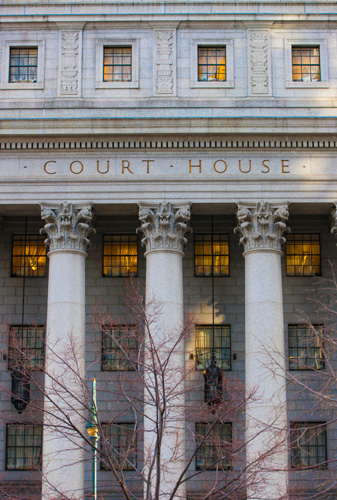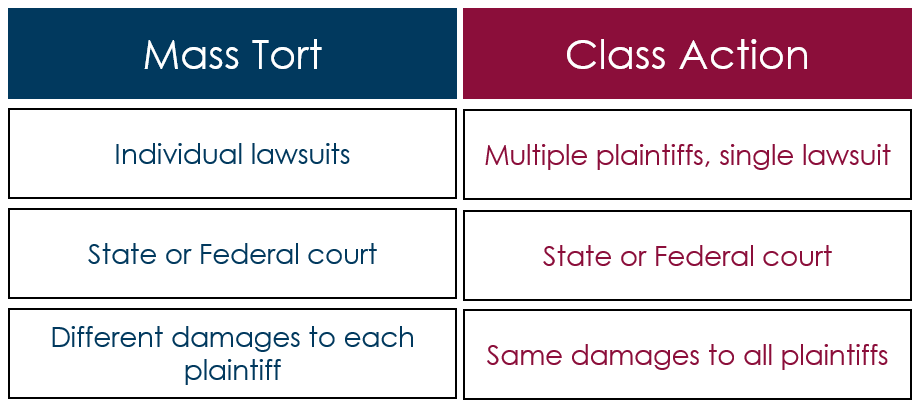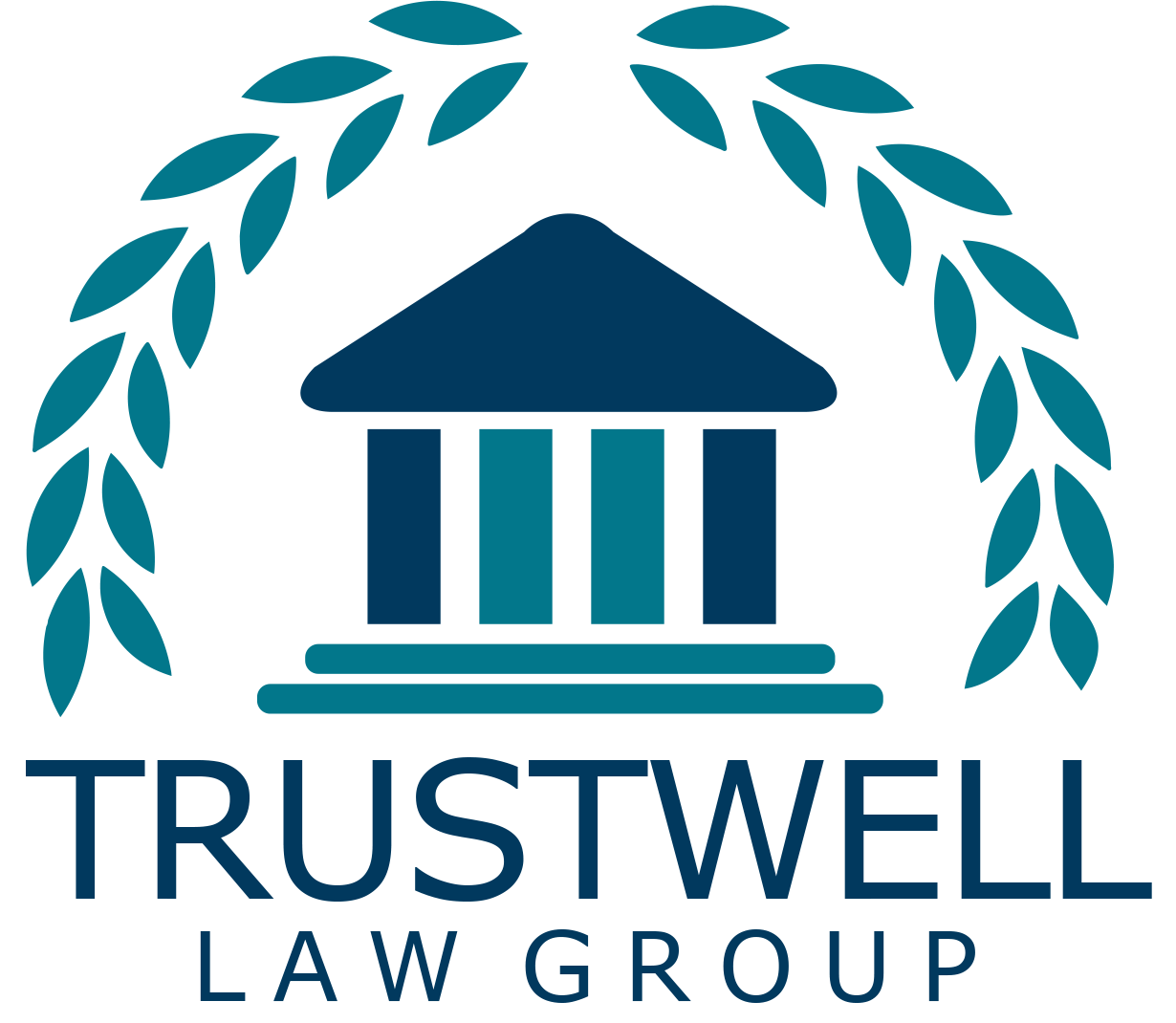Mass Torts & Class Actions

I see the phrase “mass tort” used a lot, what does that mean?
To understand the meaning of “mass tort,” you first have to understand the meaning of “tort.” A “tort” is a legal term that basically means something legally “wrong” done to a person or their property, but without violating a contract. (Breach of contract is a different type of legal “wrong.”) Some examples of torts could include threatening or striking someone, crashing into their car, tearing up their lawn, or burning down their house. Selling consumers a harmful product can also be a tort.
A “mass tort” action is not a single case. A mass tort action typically involves hundreds or thousands of individual cases in which many plaintiffs separately sue the same defendant(s). Mass tort cases arise when the defendant(s) cause many injuries by the same or similar act of harm, such as making or selling a defective product or harmful drug. In a mass tort action, the extent of the harm caused to each plaintiff — and the appropriate compensation — may vary widely. Mass tort actions can be brought in state or federal courts. To ease the logistical burden, the federal court system often consolidates mass tort claims for pre-trial purposes as multidistrict litigations. Mass tort claims can sometimes be handled in a class action, but class actions must meet very specific legal requirements.
Okay, what is a multidistrict litigation?
A multidistrict litigation (“MDL”) is a federal civil litigation in which the courts use special procedures to simplify and accelerate the handling of large numbers of complex cases with common factual issues while minimizing duplicated effort and avoiding inconsistent rulings. Congress passed the MDL statute after the courts created many of those procedures in the 1960s to handle almost 2,000 federal antitrust cases filed all over the country against the electrical equipment industry.
An MDL arises when “civil actions involving one or more common questions of fact are pending in different [judicial] districts.” (28 U.S.C. § 1407 (2018).) When cases are pending in many different districts against the same defendant(s), and share common factual issues, the Judicial Panel on Multidistrict Litigation (“JPML”) — also created by that law — decides whether those cases should be consolidated under the MDL procedures, and, if so, which court should handle them. When the JPML creates a new multidistrict litigation, all cases subject to the MDL are sent from the courts where they were filed to the court handling that MDL (the transferee court), and the transferee court supervises discovery and all pre-trial legal proceedings. While an MDL remains pending, any newly-filed federal case that would fit those criteria will be transferred in. Defense lawyers can also seek to bring some of the similar state cases into the MDL. Any case not settled or dismissed in the transferee court will be sent back to the original court for trial.
I’ve heard that MDLs have “bellwether” cases. What is a “bellwether” case?
 The word bellwether originated long ago in England as a combination of the words belle (bell) and wether (a castrated ram). Apparently, shepherds often hung a bell from the neck of a wether, which would lead their flock. In modern usage, bellwether refers to a trendsetter or a leading indicator, from which one can predict future events. That is the meaning of the term as used in an MDL.
The word bellwether originated long ago in England as a combination of the words belle (bell) and wether (a castrated ram). Apparently, shepherds often hung a bell from the neck of a wether, which would lead their flock. In modern usage, bellwether refers to a trendsetter or a leading indicator, from which one can predict future events. That is the meaning of the term as used in an MDL.
MDLs commonly involve one or more bellwether trials. The plaintiffs’ lawyers and defense lawyers, with court approval, choose one or more representative cases to go to trial.
The issues tried in those bellwethers include claims and defense theories common to many or all cases. The sides will then use the results of the bellwether trials to evaluate the strength and predict the likely outcome of the other MDL cases. A verdict in a bellwether trial can be extrapolated to the remaining cases, and the parties can use any damages awarded to help put a value on certain types of claims during settlement. But the other plaintiffs are not legally bound by the bellwether verdicts; they may choose to continue with their own trials.
What is the difference between an MDL and a class action?
They are similar in some ways, with important differences.
In a class action lawsuit, one or more plaintiffs who have suffered the same (or similar) injury caused by the same product or action sue the defendant as a group. Class actions are commonly used when the likely damages from any one claim would not justify the expense of an individual lawsuit. Taken together, though, the value of the class claims can be quite large, and a single consolidated lawsuit also consolidates the expenses and the legal resources. These factors can all also apply to an MDL.

But in a class action, the lead (“representative”) plaintiff stands in for every person who meets the criteria the court used to define the class, so the case proceeds on behalf of all plaintiffs and all potential plaintiffs who have not expressly opted out. Also, every class member who does not opt out of a settlement receives the same damages (or other court-ordered relief) if the representative plaintiff wins or settles.
A plaintiff must ask the court to declare (“certify”) their case as a class action, which is often the first major battle between the plaintiff and defense. The rules vary a bit by jurisdiction, but in general there are four core requirements for a class action: (a) the plaintiff class is so large that it’s impractical to join all members individually; (b) there are questions of law or fact common to everyone in the class; (c) the representative plaintiff(s) have claims or defenses typical of the class; and (d) the representative plaintiff(s) will properly protect the interests of the class. Other requirements include the court finding that common issues of law or fact outweigh the individual issues applying to each class member, and that a class action is the best way to “fairly and efficiently” handle the case.
Mass Tort
- Fed. Rule Civ. Proc. 23 (Class Actions). Accessed at https://www.federalrulesofcivilprocedure.org
- Merriam-Webster Dictionary Online. s.v. “Tort.” Springfield, MA: Merriam-Webster, Inc., 2019. Accessed at https://www.merriam-webster.com/dictionary/tort
- The Law Dictionary featuring Black’s Law Dictionary Free Online Legal Dictionary (2d ed.). s.v. “Class Action.” TheLawDictionary.org, 2019. Accessed at https://thelawdictionary.org/class-action/
- The Law Dictionary featuring Black’s Law Dictionary Free Online Legal Dictionary (2d ed.). s.v. “Tort.” TheLawDictionary.org, 2019. Accessed at https://thelawdictionary.org/tort/
- Rules and Procedures of the United States Judicial Panel on Multidistrict Litigation (2016). Retrieved from https://www.jpml.uscourts.gov/rules-procedures
- Tilley, Cristina. “Tort Law Inside Out.” Yale Law Journal 126 (2017): 1320-1406. Retrieved from https://www.yalelawjournal.org/pdf/TilleyFinalPDF_77fpm6vw.pdf
- Wex Legal Dictionary. s.v. “Mass Tort.” Ithaca, NY: Cornell Legal Information Institute, 2019. Accessed at https://www.law.cornell.edu/wex/mass_tort
Multidistrict Litigation (MDL)
- Administrative Office of the U.S. Courts. “Judicial Business 2018 — Judicial Panel on Multidistrict Litigation.” Washington, D.C.: GPO, 2018. Accessed at https://www.uscourts.gov/statistics-reports/judicial-panel-multidistrict-litigation-judicial-business-2018
- Administrative Office of the U.S. Courts. “Judicial Business 2018 — Judicial Panel on Multidistrict Litigation Table S-19 — Cases Transferred by Order of the U.S. Judicial Panel on Multidistrict Litigation.” Washington, D.C.: GPO, 2018. Accessed at https://www.uscourts.gov/statistics/table/s-19/judicial-business/2018/09/30
- Administrative Office of the U.S. Courts. “Judicial Business 2018 — Judicial Panel on Multidistrict Litigation Table S-20 — Cumulative Summary of Multidistrict Litigation.” Washington, D.C.: GPO, 2018. Accessed at https://www.uscourts.gov/sites/default/files/data_tables/jb_s20_0930.2018.pdf
- Bradt, Andrew. “The Long Arm of Multidistrict Litigation.” William and Mary Law Review 59, no. 4 (2018): 1165-1238. Retrieved from https://papers.ssrn.com/sol3/papers.cfm?abstract_id=3171269
- Burch, Elizabeth. “Judging Multidistrict Litigation.” N.Y.U. Law Rev. 90, no. 71 (2015): 71-142. Retrieved from https://digitalcommons.law.uga.edu/fac_artchop/994/
- Fallon, Eldon, Jeremy Grabill, and Robert Wynne. “Bellwether Trials in Multidistrict Litigation.” Tulane Law Review 82 (2008): 2323-2367. Retrieved from https://pdfs.semanticscholar.org/d567/875e53b13819bcbfd4c83f58fea3ba6b8e5c.pdf
- Rules and Procedures of the United States Judicial Panel on Multidistrict Litigation (2016). Retrieved from https://www.jpml.uscourts.gov/rules-procedures
- Zimmerman, Adam. “The Bellwether Settlement.” Fordham Law Review 85, no. 5 (2017): 2275-2298. Retrieved from https://ir.lawnet.fordham.edu/flr/vol85/iss5/39/
MDL vs. Class Action
- Bradt, Andrew. “The Long Arm of Multidistrict Litigation.” William and Mary Law Review 59, no. 4 (2018): 1165-1238. Retrieved from https://papers.ssrn.com/sol3/papers.cfm?abstract_id=3171269
- Burch, Elizabeth. “Judging Multidistrict Litigation.” N.Y.U. Law Rev. 90, no. 71 (2015): 71-142. Retrieved from https://digitalcommons.law.uga.edu/fac_artchop/994/
- Fallon, Eldon, Jeremy Grabill, and Robert Wynne. “Bellwether Trials in Multidistrict Litigation.” Tulane Law Review 82 (2008): 2323-2367. Retrieved from https://pdfs.semanticscholar.org/d567/875e53b13819bcbfd4c83f58fea3ba6b8e5c.pdf
- Fed. Rule Civ. Proc. 23 (Class Actions). Accessed at https://www.federalrulesofcivilprocedure.org
- The Law Dictionary featuring Black’s Law Dictionary Free Online Legal Dictionary (2d ed.). s.v. “Class Action.” TheLawDictionary.org, 2019. Accessed at https://thelawdictionary.org/class-action/
- Rules and Procedures of the United States Judicial Panel on Multidistrict Litigation (2016). Retrieved from https://www.jpml.uscourts.gov/rules-procedures
- Zimmerman, Adam. “The Bellwether Settlement.” Fordham Law Review 85, no. 5 (2017): 2275-2298. Retrieved from https://ir.lawnet.fordham.edu/flr/vol85/iss5/39/
Bellwether
- Cambridge Academic Content Dictionary. s.v. “Bellwether.” Cambridge, UK: Cambridge University Press, 2019. Accessed at https://dictionary.cambridge.org/us/dictionary/english/bellwether
- Fallon, Eldon, Jeremy Grabill, and Robert Wynne. “Bellwether Trials in Multidistrict Litigation.” Tulane Law Review 82 (2008): 2323-2367. Retrieved from https://pdfs.semanticscholar.org/d567/875e53b13819bcbfd4c83f58fea3ba6b8e5c.pdf
- Merriam-Webster Dictionary Online. s.v. “Bellwether.” Springfield, MA: Merriam-Webster, Inc., 2019. Accessed at https://www.merriam-webster.com/dictionary/bellwether
- Zimmerman, Adam. “The Bellwether Settlement.” Fordham Law Review 85, no. 5 (2017): 2275-2298. Retrieved from https://ir.lawnet.fordham.edu/flr/vol85/iss5/39/
